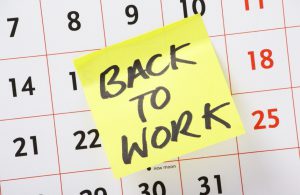Effective Onsite Medical Programs
From medical bills, to lost productivity, to the emotional toll that an accident takes on injured employees, employers face skyrocketing costs associated with workers’ compensation claims. This panel at WCI’s 2017 Workers’ Compensation Educational Conference highlighted how onsite therapy can help properly manage workplace injuries when they occur. The panel included: Jaime Sigurdsson, CEAS, Director of Workers’ Compensation, CORA Health Services, Inc. Suzanne Mayberry, Associate Leave Manager, JM Family Enterprises, Inc. Sandra Santiago, ARNP, Crew Case Manager, Carnival Cruise Lines An onsite medical program is made up of two essential elements: 1. Prevention Pre-Injury Program Job site analysis. Safety seminars/body
(Read the full article…)
The Rising Costs of Workers’ Compensation Tail Claims
One of the things that makes workers’ compensation such a challenge for employers and carriers is the long-tail nature of the claims. This long tail means that premiums collected today must cover losses for years to come. The rising costs of these tail claims has a significant impact on both carriers and employers in terms of cost of insurance today and future reserves. At the WCI’s 2017 Workers’ Compensation Educational Conference a group discusses the financial impact of these growing liabilities on industry and provides strategies for reducing them. The speakers for this session were Matthew Cohen, VP Client Services,
(Read the full article…)
Return-To-Work Challenges & Opportunities
Establishing an effective return-to-work program is widely accepted as one of the most significant cost-saving measures for managing employees’ workers’ compensation injuries. This panel discussion at WCI’s 2017 Workers’ Compensation Educational Conference reviewed trends in return-to-work program administration. The panel included: Frances Ford, Co-Founder, ReEmployAbility (moderator) Nathan Hughes, Director of Risk Management, Safelite Group Jodie Massingill, Senior Manager of Casualty Claims, Sysco Corporation Patricia Rodriguez, Return-to-Work Specialist, Crum & Forster Research supports that returning employees to work through transitional duty not only provides cost containment, but it can also help reduce the incidence of depression, improve worker morale, and promote
(Read the full article…)
Advancements in Employee Advocacy
Advocacy has emerged as a very effective means for addressing work-related issues and the many challenges they pose. This session at WCI’s 2017 Workers’ Compensation Educational Conference provided an in-depth discussion of how an advocacy approach works and the benefits it can produce. The panel included: Max Koonce, Managing Director, Sedgwick Claims Management Services (moderator) Janice Van Allen, Senior Director, Risk Management, Walmart Stores, Inc. Stephanie Wood, Claims Manager, The Wendy’s Company Laura M. Rodgers, ARM, Senior Claims Manager, Pier 1 Imports, Inc. A workplace injury and the complexity of the workers’ compensation system can create apprehension and anxiety for
(Read the full article…)
Analytics & Pricing in Workers’ Compensation
Advances in the way the workers’ compensation industry collects analytics are rapidly changing the way we do business. In this session at WCI’s 2017 Workers’ Compensation Educational Conference, Frank Pennachio, Agent at Oceanus Partners, provided a future outlook for workers’ compensation data analytics trends and how they relate to pricing. The industry is experiencing dramatic change due to technological disrupters. Gordon Moore, co-founder of Intel, predicted that the processing speed of a computer chip will double every two years. This has happened. We have extraordinarily fast computers and massive data storage that is essentially free. In addition, the amount of
(Read the full article…)
What’s Right With Workers’ Compensation
Workers’ compensation is a positive change-agent in the claims arena and beyond. Despite this, the workers’ compensation system is under attack. While there are certainly problems with the system, there is more good news than bad news in the system, which is a demonstrably successful benefit delivery vehicle. The system has also proven to be a successful change-agent, promoting much needed reform, particularly in the areas of medicine, safety, and rehabilitation. At the WCI’s 2017 Workers’ Compensation Educational Conference a panel of experts discuss what’s right with workers compensation. The panel included: Darrell Brown, Chief Claim Officer, Sedgwick Brian Allen, Vice
(Read the full article…)
Investing in Workers’ Compensation
In recent years, we have seen significant private equity investment in workers’ compensation vendors. Why are they interested in workers’ compensation? What are they looking for when they make investments? At the WCI’s 2017 Workers’ Compensation Educational Conference Kimberly George, Sedgwick Claims Management Services lead a panel in a discussion around investing in your workers’ compensation. The panel included: -Dave North, President and CEO, Sedgwick Claims Management Services -Shelley Boyce, CEO, MedRisk -Jeff Livingston, Principal, Private Equity, KKR & Co. -Jeffrey McKibben, Managing Principal, Odyssey Investment Partners, LLC The industry is fragmented and there are opportunities to
(Read the full article…)
Winning Strategies for Workers’ Compensation Risk Management
This session at WCI’s 2017 Workers’ Compensation Educational Conference highlighted program strategies from the three winners of National Underwriter P&C’s 2017 Excellence in Workers’ Compensation Risk Management Award. Nations Roof LLC Neftali Ortiz, Director of Risk Management This roofing contractor has 22 offices throughout the U.S. and has grown by 61% in revenue in just four years. Yet, while the company has been growing rapidly, claims frequency has decreased by 25%. The company’s employees are exposed to extreme risks like fatal falls and heat illness. The secrets to their safety success was a shift in focus to safety training and
(Read the full article…)
Making Risk Management a Business Imperative
Effectively communicating the importance of risk management fundamentals in a way that business operations and leadership can understand is critical to the success of any risk manager. During a session at the WCI’s 2017 Workers’ Compensation Educational Conference a panel of speakers discussed three diverse perspectives in risk management and how to effectively gain agreement across business. The panel included: -Michele Adams, Vice President, Risk Management Services, Walt Disney World Resort(Moderator) -Michael P. Fenlon, ARM, ARe, CPCU, Sr. Director, UPS Global Risk Management -Steve Perroots, Vice-President, Global Claims and Occupational Health Services, Marriott International,Inc. -Kurt Leisure, Vice President,
(Read the full article…)
Understanding the Agent’s Role in Claims
Does an agent have a role in the workers’ compensation claim process? Can agents bring value to the table in resolving a benefit dispute? This session at WCI’s 2017 Workers’ Compensation Educational Conference illustrated how important it is for agents to be engaged before and after a compensable accident. The panel included: Steve Coonrod, Attorney, McConnaughhay, Coonrod, Pope, Weaver & Stern, PA (moderator) Bob O’Halloran, Senior Vice President of Claims, Summit Consulting, Inc. Liz Alipio, Assistant Vice President, Zenith Insurance Company Randall T. Porcher, Attorney, Morgan & Morgan The agent has an important role before and after workers’ compensation claims.
(Read the full article…)











